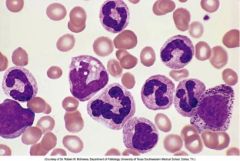![]()
![]()
![]()
Use LEFT and RIGHT arrow keys to navigate between flashcards;
Use UP and DOWN arrow keys to flip the card;
H to show hint;
A reads text to speech;
19 Cards in this Set
- Front
- Back

peripheral blood smear showing immature myeloid cells (with bands) is suggestive of what condition?
|
Chronic myeloid leukemia (CML)
|
|
|
proto-oncogenes exist in normal cells and become an active oncogene by what mechanisms (3)
|
point mutation, amplification of gene expression, translocation (of a promotor or of a gene fragment to form a chimeric protein)
|
|
|
describe Ras gene activation in cancer
|
Ras - normally quickly inactivated by the loss of GTP - becomes locked to GTP leading to continuous cell cycle progression
|
|
|
what kind of mechanism leads to activation of Ras
|
point mutation
|
|
|
what mechanism is involved with the N-myc gene in causing neuroblastoma?
|
gene amplification
|
|
|
having >10 copies of N-Myc in neuroblastoma is correlated with what kind of outcome?
|
poorer survival
|
|
|
one of the fastest growing human cancers; a type of B cell lymphoma
|
Burkitt Lymphoma
|
|
|
genetic mechanism involved in causing Burkitt Lymphoma
|
translocation of chromosomes 8 and 14 -- enhancer for IgH genes on chr 14 fuses with Myc gene on chr 8 leading to Myc enhancement
|
|
|
What is the philadelphia chromosome and what condition is it involved in
|
an unequal reciprocal translocation between chromosomes 9 and 22; causes CML
|
|
|
what protein does the philadelphia chromosome encode
|
BCR-ABL - a constituitively active tyrosine kinase that phosphorylates leading to cell growth
|
|
|
How does Imantinib (Gleevec) work?
|
it mimics ATP and binds to the ATP binding site on BCR-ABL; without bound ATP, BCR-ABL can't phosphorylate it's target
|
|
|
what kind of experiment was used to determine whether the cancer "phenotype" was dominant or recessive? what was the outcome?
|
cell fusion experiment; recessive (lead to discovery that there are normal mechanisms in the cell that prevent cancer)
|
|
|
What is Knudson's "two-hit" hypothesis for the formation of retinoblastoma?
|
a "hit" or mutation on both alleles is required to get tumor formation; in familial retinoblastoma, one hit is already inherited so it is easier to develop the other, somatic "hit"
|
|
|
the two hit hypothesis applies to what types of genes
|
tumor suppressor genes
|
|
|
what is loss of heterozygosity?
|
one allele is mutated (usually the germ line allele) and the second "hit" is a deletion, so the gene appears homozygous for the mutation
|
|
|
The "molecular policeman" of the cell cycle that guards the G1/S phase transition is what?
|
Rb
|
|
|
explain the relationship of phosphorylation and Rb with progression of the cell cycle
|
to suppress cell growth - Rb normally binds E2F to prevent progression into S phase
when phosphorylated by cyclin D or CDKs - Rb doesn't bind E2F and S phase is entered |
|
|
the most commonly mutated gene in cancer is _____.
|
p53
|
|
|
_________ controls the degradation of p53
|
MDM2
|

